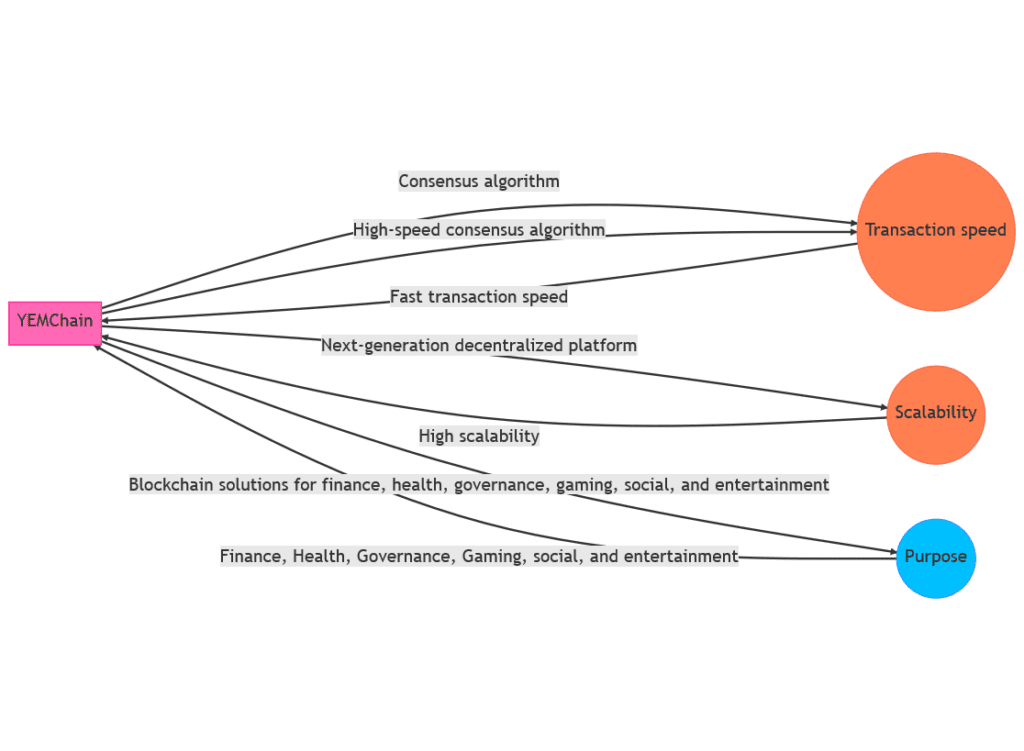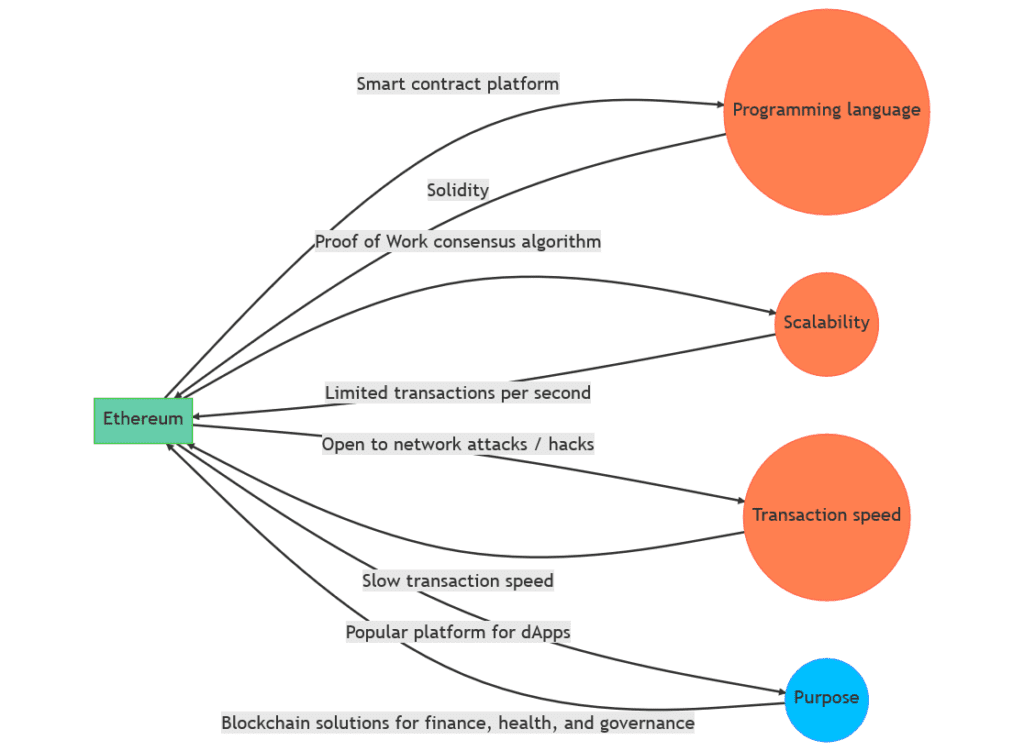1. Introduction
Explanation of YEMChain and Ethereum
Blockchain technology has revolutionized the world of finance and security, with new platforms emerging every year. Two of the most popular blockchain platforms are YEMChain and Ethereum. In this article, we will introduce YEMChain and Ethereum, exploring their features, applications, and history.
a. YEMChain
YEMChain is an innovative blockchain technology that combines the best features of blockchain and cybersecurity. It provides fast, secure, transparent, and low-fee transactions with high-level encryption, making it an ideal platform for various applications. YEMChain aims to empower businesses and individuals to transact with each other in a trustless environment, without the need for intermediaries.
b. Ethereum
Ethereum is a decentralized software platform that enables Smart Contracts and Distributed Applications (ĐApps) to be built and run without any downtime, fraud, or control. Launched in 2015, Ethereum is powered by its own cryptocurrency called ‘Ether’. Ethereum has a large and committed global community and the largest ecosystem in blockchain and cryptocurrency, making it a versatile platform for creating various decentralized applications (Dapps). Besides being used as a digital currency, Ether is also used to pay for the computational resources and transaction fees for any transaction executed on the Ethereum network. The Ethereum network is currently famous for allowing the implementation of smart contracts and other transactions, making it possible to create and run applications on a decentralized network.
In summary, YEMChain and Ethereum are two of the most innovative blockchain technologies available today, with different features and applications. While YEMChain provides a fast, secure, transparent, and low-fee environment for various transactions, Ethereum enables the creation of decentralized applications and the execution of smart contracts on a decentralized network.
2. YEMChain vs Ethereum: Overview
YEMChain Overview and Features

YEMChain is a relatively new blockchain platform that offers unique features and benefits for users. The YEMChain platform is built on the concept of community-driven development, where users are encouraged to participate actively in the platform’s governance and decision-making processes. Some of the essential features of YEMChain are as follows:
Consensus Mechanism: YEMChain uses a consensus mechanism called Delegated Proof of Stake (DPoS). This consensus mechanism is more energy-efficient than the Proof of Work (PoW) consensus mechanism used by Bitcoin and other early blockchain platforms.
High TPS: YEMChain can process up to 100 transactions per second (TPS). This is significantly higher than Ethereum’s current TPS, which is around 30.
Scalability: YEMChain is highly scalable, making it suitable for use cases that require a large number of transactions to be processed quickly and efficiently.
Smart Contract Functionality: YEMChain supports the definition and execution of smart contracts, allowing developers to implement decentralized applications (DApps) on the platform.
Ethereum Overview and Features

Ethereum is one of the most popular blockchain platforms, and it offers a wide range of features and benefits for developers and users. Some of the essential features of Ethereum are as follows:
Consensus Mechanism: Ethereum uses a consensus mechanism called Proof of Stake (PoS), which is more energy-efficient than the PoW consensus mechanism used by Bitcoin and other early blockchain platforms. Ethereum’s PoS consensus mechanism is designed to be more scalable than the PoW consensus mechanism used by Bitcoin.
Smart Contract Functionality: Ethereum is well-known for its support of smart contracts. Smart contracts are self-executing contracts that allow developers to build DApps on the platform.
Decentralized Applications: Ethereum allows developers to build DApps on the platform, enabling the creation of a wide range of decentralized applications, including decentralized finance (DeFi) applications, gaming applications, and more.
Ethereum Virtual Machine (EVM): Ethereum’s EVM is a powerful tool that allows developers to execute smart contracts on the Ethereum blockchain.
In conclusion, both YEMChain and Ethereum offer unique features and benefits for developers and users. While YEMChain is a relatively new platform, it offers high TPS and scalability, making it suitable for use cases that require a large number of transactions to be processed quickly and efficiently. On the other hand, Ethereum is a well-established platform with a wide range of features and benefits, including support for smart contracts and DApps.
3. Security and Privacy
Explanation of the importance of security and privacy in blockchain technology
Blockchain technology has revolutionized the way we transfer and store data, but with this innovation comes the responsibility to ensure the security and privacy of the information being exchanged. Blockchain transactions are designed to be transparent and immutable, but this also means that any security breaches could have far-reaching consequences. Therefore, it is essential to maintain the integrity of the blockchain by implementing robust security and privacy measures. These measures should include strong encryption, multi-factor authentication, and regular security audits to prevent unauthorized access and maintain the privacy of users’ data.
YEMChain’s security and privacy features
YEMChain is a blockchain platform that places a high priority on security and privacy. Its security features include advanced encryption techniques, peer-to-peer verification, and a decentralized consensus mechanism that ensures the integrity of transactions. Additionally, YEMChain has implemented privacy features such as zero-knowledge proofs and ring signatures, which enable users to remain anonymous while still participating in the network. These features help to maintain the confidentiality of user data and prevent unauthorized access.
Ethereum’s security and privacy features
Ethereum, the second-largest blockchain platform, also places a strong emphasis on security and privacy. Its security features include a robust consensus mechanism, which makes it difficult for bad actors to manipulate the blockchain. Additionally, Ethereum uses smart contracts, which are self-executing and can enforce rules automatically, reducing the risk of human error. Ethereum also supports private transactions, enabling users to conduct confidential transactions without revealing their identities or transaction details to the public. These privacy features are achieved using technologies such as zk-SNARKs and ring signatures.
Comparison of YEMChain and Ethereum in terms of security and privacy
When it comes to security and privacy, comparing YEMChain and Ethereum can be an interesting exercise. While both networks use a proof-of-stake consensus mechanism, they have different approaches to these issues. Here is a breakdown of how each platform addresses security and privacy concerns:
Security:
Ethereum: Ethereum has experienced security incidents in the past, with smart contract vulnerabilities leading to the loss of funds. However, the network recently completed the Merge, which shifted it from a proof-of-work to a proof-of-stake consensus mechanism. This move has reduced energy consumption and may help address some security concerns. However, there are also concerns that Ethereum’s shift to proof-of-stake may raise regulatory issues.
YEMChain: Information on YEMChain’s security measures is limited, and it’s unclear how the platform handles potential security threats.
Privacy:
Ethereum: Historically, Ethereum has had difficulty maintaining user privacy on-chain. However, the Merge may have improved the network’s ability to conduct necessary computations and protect user privacy. More privacy-focused solutions may be necessary, however.
YEMChain: From the public’s perspective, it’s unclear how YEMChain handles user privacy on-chain, as there is limited information available on the platform.
In summary, both YEMChain and Ethereum use a proof-of-stake consensus mechanism, but there is more information available about Ethereum’s security and privacy measures. Ethereum has had security incidents in the past but has recently completed the Merge, which may have improved privacy protections. However, there are concerns that Ethereum’s shift to proof-of-stake may raise regulatory issues. Meanwhile, there is limited information available on YEMChain’s security and privacy measures, it has kept all this secret and in-house, therefore far less likely to attacks and breeches.
4. Transaction Speed and Fees
Explanation of Transaction Speed and Fees in Blockchain Technology:
Blockchain technology is known for its decentralized and secure nature, which makes it ideal for peer-to-peer transactions. However, every blockchain has its own transaction speed and fee structure that users need to understand before using it. Here are some key points to consider:
Transaction speed: The transaction speed of a blockchain refers to how quickly a transaction can be validated and added to the blockchain ledger. This speed varies from one blockchain to another and can be affected by factors like network congestion, the complexity of the transaction, and the consensus mechanism used by the blockchain.
Transaction fee: The transaction fee is the amount of cryptocurrency that a user must pay to have their transaction processed and added to the blockchain. The fee structure varies based on the blockchain, but generally, the higher the fee, the faster the transaction will be processed.
YEMChain’s Transaction Speed and Fee Structure:
YEMChain is a blockchain that claims to have a transaction speed of up to 100 transactions per second (TPS). It uses a Proof-of-Stake (PoS) consensus mechanism that allows validators to stake their coins and earn rewards for validating transactions. YEMChain’s fee structure is based on a gas system, similar to Ethereum, where users must pay a certain amount of YEM (the native cryptocurrency) per gas to have their transaction processed.
Ethereum’s Transaction Speed and Fee Structure:
Ethereum is one of the most popular blockchain platforms, known for its smart contract capabilities. Its current transaction speed is approximately 15 transactions per second (TPS), which is much slower compared to other blockchains. Ethereum uses a fee market system, where users must bid on transaction fees to have their transaction processed by miners. The higher the fee, the faster the transaction will be confirmed. The fee is calculated in gas, where each operation on the blockchain requires a certain amount of gas to execute. The gas price is denominated in Gwei, which is a fraction of Ether (the native cryptocurrency).
Comparison of YEMChain and Ethereum in terms of transaction speed and fees
When it comes to transaction speed and fees, YEMChain and Ethereum are two popular blockchain platforms that are worth comparing. YEMChain boasts a low transaction fee of 0.01% and a high transaction processing speed of up to 100 transactions per second (TPS), while Ethereum has higher gas fees and a lower TPS rate. Let’s take a closer look at the available information on the transaction speed and fees of these platforms.
YEMChain:
YEMChain is a blockchain platform that claims to offer high-speed, low-cost transactions. According to their website, YEMChain can handle up to 100 TPS. However, we could not find any information on the actual transaction speed of YEMChain in practice. As for fees, YEMChain has a low transaction fee of 0.01%, which is significantly lower than the fees charged by many other blockchain platforms. For many transaction types the fee is waived, such as on Cashback and Reward transactions.
Ethereum:
Ethereum is one of the most popular blockchain platforms, but it is known for having higher gas fees and a lower TPS rate compared to some other platforms. The average base gas fee for an Ethereum transaction is 31 Gwei, or $2.03, as of the time of writing. Ethereum’s TPS rate is lower than YEMChain, although it depends on several factors such as network load, complexity of the transaction, etc..
In conclusion, transaction speed and fee structure are important considerations when using blockchain technology. Each blockchain has its own unique speed and fee structure, so it’s essential to understand them before conducting transactions. YEMChain and Ethereum both have different transaction speeds and fee structures, which users must keep in mind when using these platforms.
5. Smart Contracts and Decentralized Applications (DApps)
Explanation of Smart Contracts and Decentralized Applications (DApps)
Smart contracts and decentralized applications (DApps) are two essential components of the blockchain ecosystem. Smart contracts are digital agreements that execute automatically when specific predetermined conditions are met. These contracts are written in code and run on a decentralized network, without the need for a central authority to oversee their execution. DApps, on the other hand, are programs that operate on a blockchain network, but their strength comes from smart contracts. DApps and blockchain networks communicate with each other through smart contracts, which act as a backend mechanism. DApps combine a front-end interface and smart contracts to deliver a complete application experience.
YEMChain’s Smart Contract and DApp Capabilities
YEMChain is a decentralized blockchain network that offers smart contract and DApp capabilities. The YEMChain platform allows users to define their own smart contracts, which can execute automatically based on predefined conditions. YEMChain also offers developers a complete suite of tools and APIs to build DApps on its platform. The Smart Contracts themselves are vetted, tested and implemented by YEMChain and not a user, for increased security.
Ethereum’s Smart Contract and DApp Capabilities
Ethereum is one of the most widely used blockchain networks for developing smart contracts and DApps.
The Ethereum platform offers a robust programming language called Solidity, which developers can use to write and deploy smart contracts on the Ethereum network. Ethereum also provides a user-friendly interface for creating and deploying DApps.
Comparison of YEMChain and Ethereum in Terms of Smart Contracts and DApps
YEMChain and Ethereum differ in terms of their smart contract and DApp capabilities. While both platforms allow users to define smart contracts, YEMChain offers a more user-friendly experience with its suite of developer tools and APIs. Ethereum, on the other hand, has a more established developer community and offers a wider range of development tools, including a robust programming language called Solidity. In terms of DApps, both platforms offer a user-friendly interface for creating and deploying DApps, but Ethereum has a more established ecosystem of DApps. Ultimately, the choice between YEMChain and Ethereum will depend on the specific needs of the developer and the project at hand.
6. Adoption and Community
Importance of Adoption and Community in Blockchain Technology
Adoption and community play an essential role in the development and success of blockchain technology.
Blockchain is a digitized, decentralized, public ledger of all cryptocurrency transactions. As it constantly grows, the adoption of blockchain technology has become more mainstream, moving from the experimental edges of an organization to the core of its work. Successful blockchain adoption requires the support of a community, which can drive innovation and provide feedback.
YEMChain’s Adoption and Community
YEMChain is a blockchain network designed to support sustainable community development. Its adoption and community are essential to its success. YEMChain’s community is actively involved in promoting and supporting the project. As a result, it has attracted a large and dedicated user base. YEMChain’s adoption is focused on providing essential services such as banking to people who may not have access to traditional banking.
Ethereum’s Adoption and Community
Ethereum is one of the most popular blockchain platforms in the world and has a robust adoption and community. The Ethereum community consists of developers, investors, and users who contribute to the platform’s development and growth. The community also supports and encourages the development of decentralized applications (dApps) on the Ethereum network. Ethereum’s adoption has been primarily driven by the popularity of its smart contract feature, which allows developers to build dApps on top of the Ethereum blockchain.
Comparison of YEMChain and Ethereum in terms of Adoption and Community
YEMChain and Ethereum have different approaches to adoption and community, but both are vital to their success. YEMChain’s adoption is focused on providing essential services such as banking to people who may not have access to traditional banking, whereas Ethereum’s adoption has been primarily driven by the popularity of its smart contract feature, which allows developers to build dApps on top of the Ethereum blockchain. YEMChain’s community is actively involved in promoting and supporting the project, whereas Ethereum’s community consists of developers, investors, and users who contribute to the platform’s development and growth. Both YEMChain and Ethereum have strong adoption and community support, which are essential to their success in the blockchain industry.
7. Conclusion
Summary of key points:
YEMChain and Ethereum are two blockchain technologies that differ in various aspects. YEMChain is built on the SafeZone cybersecurity platform, providing a high level of security and privacy to users with fast, low-fee transactions. Ethereum, on the other hand, is a blockchain network that enables the creation of decentralized applications and smart contracts. YEMChain has a faster block time, taking only seconds to confirm a transaction, while Ethereum transactions are confirmed in minutes. Ethereum uses a consensus algorithm known as Proof-of-Stake (PoS), while YEMChain uses the SafeZone PoS algorithm.
Final thoughts on the comparison between YEMChain and Ethereum:
While both blockchain technologies offer unique features, the choice between them depends on the intended use case. YEMChain is designed to provide high levels of security and privacy to users with fast, low-fee transactions. Ethereum, on the other hand, offers a more versatile platform for developing decentralized applications and smart contracts.
However, it’s important to note that Ethereum has faced congestion issues in the past, leading to high gas fees for users. Overall, the choice between YEMChain and Ethereum depends on the specific needs of the user, and both blockchain technologies have their own strengths and weaknesses.
